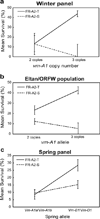Copy number and haplotype variation at the VRN-A1 and central FR-A2 loci are associated with frost tolerance in hexaploid wheat
- PMID: 24626953
- PMCID: PMC4876961
- DOI: 10.1007/s00122-014-2290-2
Copy number and haplotype variation at the VRN-A1 and central FR-A2 loci are associated with frost tolerance in hexaploid wheat
Abstract
The interaction between VRN - A1 and FR - A2 largely affect the frost tolerance of hexaploid wheat. Frost tolerance is critical for wheat survival during cold winters. Natural variation for this trait is mainly associated with allelic differences at the VERNALIZATION 1 (VRN1) and FROST RESISTANCE 2 (FR2) loci. VRN1 regulates the transition between vegetative and reproductive stages and FR2, a locus including several tandemly duplicated C-REPEAT BINDING FACTOR (CBF) transcription factors, regulates the expression of Cold-regulated genes. We identified sequence and copy number variation at these two loci among winter and spring wheat varieties and characterized their association with frost tolerance. We identified two FR-A2 haplotypes-'FR-A2-S' and 'FR-A2-T'-distinguished by two insertion/deletions and ten single nucleotide polymorphisms within the CBF-A12 and CBF-A15 genes. Increased copy number of CBF-A14 was frequently associated with the FR-A2-T haplotype and with higher CBF14 transcript levels in response to cold. Factorial ANOVAs revealed significant interactions between VRN1 and FR-A2 for frost tolerance in both winter and spring panels suggesting a crosstalk between vernalization and cold acclimation pathways. The model including these two loci and their interaction explained 32.0 and 20.7 % of the variation in frost tolerance in the winter and spring panels, respectively. The interaction was validated in a winter wheat F 4:5 population segregating for both genes. Increased VRN-A1 copy number was associated with improved frost tolerance among varieties carrying the FR-A2-T allele but not among those carrying the FR-A2-S allele. These results suggest that selection of varieties carrying the FR-A2-T allele and three copies of the recessive vrn-A1 allele would be a good strategy to improve frost tolerance in wheat.
Conflict of interest statement
The experiments in this manuscript comply with the current laws of the United States. The authors declare that they have no conflict of interest.
Figures



References
-
- Båga M, Chodaparambil SV, Limin AE, Pecar M, Fowler DB, Chibbar RN. Identification of quantitative trait loci and associated candidate genes for low-temperature tolerance in cold-hardy winter wheat. Funct Integr Genomics. 2007;7:53–68. - PubMed
-
- Chen Y, Carver BF, Wang S, Zhang F, Yan L. Genetic loci associated with stem elongation and winter dormancy release in wheat. Theor Appl Genet. 2009;118:881–889. - PubMed
-
- Chen Y, Carver BF, Wang S, Cao S, Yan L. Genetic regulation of developmental phases in winter wheat. Mol Breed. 2010;26:573–582.
-
- Dhillon T, Stockinger EJ. Cbf14 copy number variation in the A, B and D genomes of diploid and polyploid wheat. Theor Appl Genet. 2013;126:2777–2789. - PubMed
Publication types
MeSH terms
Substances
Grants and funding
LinkOut - more resources
Full Text Sources
Other Literature Sources

